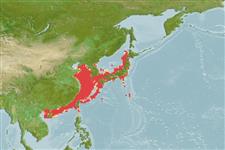Preferred temperature (Referencia
123201): 13 - 24.5, mean 19.2 °C (based on 181 cells).
Phylogenetic diversity index (Referencia
82804): PD
50 = 0.5000 [Uniqueness, from 0.5 = low to 2.0 = high].
Bayesian length-weight: a=0.00288 (0.00153 - 0.00545), b=3.15 (2.97 - 3.33), in cm total length, based on LWR estimates for this species & (Sub)family-body (Ref.
93245).
Nivel trófico (Referencia
69278): 4.5 ±0.8 se; based on diet studies.
Generation time: 2.1 ( na - na) years. Estimated as median ln(3)/K based on 2
growth studies.
Resiliencia (Referencia
120179): Medio, población duplicada en un tiempo mínimo de 1.4-4.4 años (K=0.7; Fec>100,000).
Prior r = 0.57, 95% CL = 0.37 - 0.85, Based on 1 data-limited stock assessment.
Fishing Vulnerability (Ref.
59153): Low to moderate vulnerability (34 of 100).
🛈
Climate Vulnerability (Ref.
125649): High vulnerability (58 of 100).
🛈
Nutrients (Ref.
124155): Calcium = 13.3 [4.9, 52.9] mg/100g; Iron = 0.325 [0.125, 0.917] mg/100g; Protein = 20.6 [19.1, 22.0] %; Omega3 = 0.47 [0.25, 0.94] g/100g; Selenium = 21.4 [6.2, 103.2] μg/100g; VitaminA = 8.35 [1.43, 54.86] μg/100g; Zinc = 0.31 [0.19, 0.53] mg/100g (wet weight); based on
nutrient studies. 